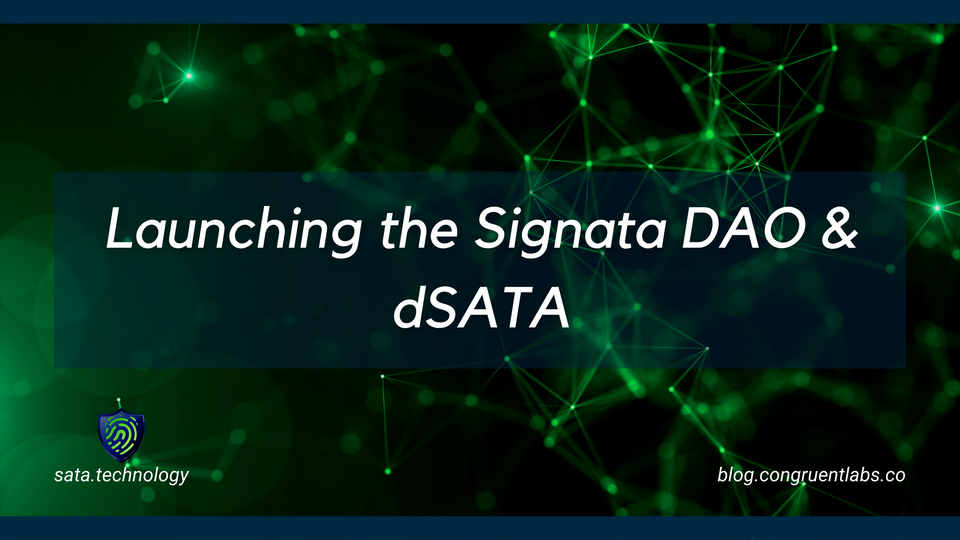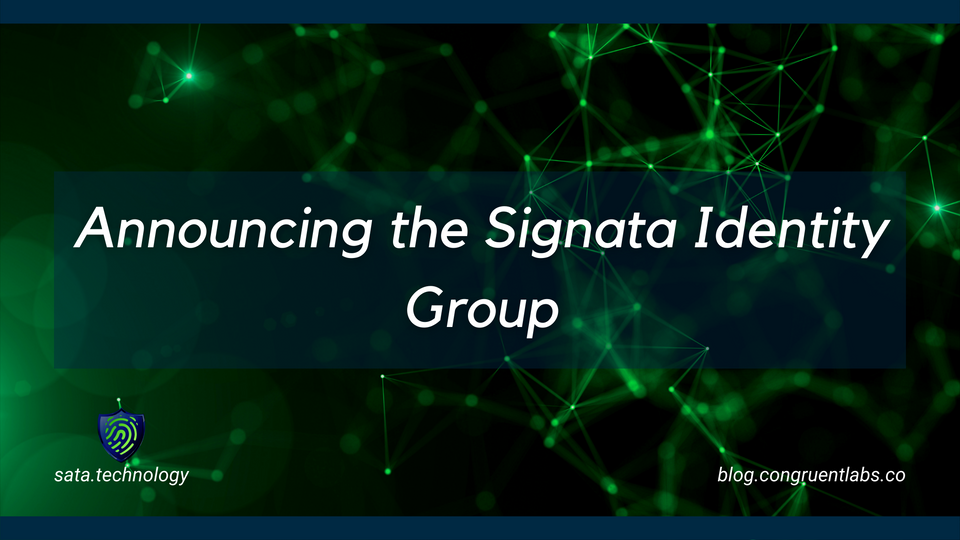When we released the SATA token project we had given little consideration to the governance of the token. Our focus has been development of our technology first, and the token management has been something we have been adapting through our agile release cycle for the project. Naturally, once we launched and received the community response that we did, we had to turn more attention to clearly defining the token structure itself to satisfy the demands of the current crypto-sphere. As part of this we have adapted our token release schedule to be slower to match changes in our product release schedule. And more importantly, we have also realised that our current governance structure (that our legal entity retains all control over the token) will hinder us longer term.
Historically, crypto projects - once reaching a certain size - run into issues of definition around the use of tokens as securities for the companies controlling them, such as the lawsuit opened against Ripple Labs. Our intention for the SATA token is to not use it as a security (our company is already controlled by private shares); ultimately, the SATA token itself is only one of many things we are building, so we need to clearly define that the token and its governance only apply to the token and not to any other products we are releasing. Products like signata.net are built, and will be extended, to utilise the token at a utility level (otherwise what is the point of the token project at all?).
Therefore, we are adding a token governance layer to withdraw absolute control from the Congruent Labs legal entity, and we're going to do it in a particularly unique way. This approach will implement the new governance mechanics we have detailed in our newly released whitepaper, which can be read here.
Fungibility & Governance
A core feature of the SATA token is the registration of rights in the form of Non-Fungible Tokens (NFTs). If you don't know what an NFT is, a "Fungible Token" is like the SATA token itself - you might hold 10 of them, and every one of those 10 tokens is identical. When you trade a fungible token, you're just transferring some number of them to another person, much like how we transfer real money around. Whereas with NFTs, being Non-Fungible means each token is unique. If I transfer an NFT to someone, then I need to specify exactly which NFT I am transferring, and this is typically represented by a specific number.
If you were thinking NFTs are artworks on the blockchain, then you're half correct. That's just one (popular) way NFTs have been used, where each token links to a unique piece of art, and is traded around, sometimes for a lot of money. But that's not exactly what NFTs were intended for being used in practice.
In fact, we realised this NFT capability could be taken advantage of in a more functional way, and that is by applying them to governance. Why simply assign voting rights for a project to the fungible tokens, when you can assign those rights as NFTs? This was a natural fit for the SATA project, as we have already built the NFT rights contract. We just needed to define how this new governance model will work, which we will explain in more detail below.
Signata Governance Structure
Signata will define the following classes of NFT for project governance:
- Project Custodians
- Partners & Liquidity Providers
- Early Holders & Standard Stakers
- Standard Holders
Each of these classes will bear an NFT with a potential multiplier for voting rights, as well as a potential expiry event for those rights. Each NFT provides the bearer with the ability to participate in governance decisions for the token project.
These additional rules allow a transitional phase for our team to steer the project towards the original intent of the project (as detailed in the token whitepaper), but eventually over time concede those rights to the overall market. It also allows any project partners, liquidity providers, and early holders to obtain similar elevated rights as a reward incentive for participating in the project in its early stages.
Staking plays a part in this structure, but more on that later in this article.
Project Custodians
The Project Custodians class is reserved for tokens held unlocked in the Congruent Labs treasury.
This class of NFT will expire once 50% of the token supply has entered circulation, and will not be reinstated after this event.
Each Project Custodian NFT will have a voting multiplier of 3. This means if 100 SATA is applied to a vote by this NFT holder, they are worth 300 votes.
Partners & Liquidity Providers
The Partners & Liquidity Provider class is reserved for all token holders that choose to list as partners with the token project, and also those that provide liquidity on Uniswap v3.
Each Partner/LP NFT will have a voting multiplier of 2. For this class of NFT, the maximum number of multiplied votes will not exceed the number of tokens that were originally purchased.
This class of NFT will expire once 75% of the token supply has entered circulation, and will not be reinstated after this event.
Each Partner/LP NFT will have a voting multiplier of 2. This means if 100 SATA is applied to a vote by this NFT holder, they are worth 200 votes.
Early Holders & Standard Stakers
A snapshot of all early token holders will take place on the 14th of August, 2021. All SATA holders at this point will be eligible to claim an early holder NFT.
This class of NFT will expire once 75% of the token supply has entered circulation, and will not be reinstated after this event.
Each Early Holder NFT will have a voting multiplier of 1.5. This means if 100 SATA is applied to a vote by this NFT holder, they are worth 150 votes.
Standard Holders
All holders of SATA tokens will be eligible to claim a governance NFT. Standard Holder NFTs will have no voting multiplier. 1 SATA applied by this NFT holder is worth 1 vote.
Governance Implementation Plan
As the token is already released onto mainnet, and a number of tokens have already entered circulation, these rules will be applied retrospectively as part of the migration towards decentralized governance.
Phase 1: Implementation Plan
This is the post you're currently reading, but in conjunction with our released whitepaper it will be open to the public to provide feedback to us. Should we receive critical feedback that requires us to modify this plan, we will naturally respond and adjust accordingly.
Phase 2: Staking Services
To reward project partners and early holders, as well as further increase supply circulation, staking services will be released. Any user that participates with these staking programs will earn SATA at rates to be announced soon, and will be eligible to claim unique governance NFTs for the project.
Phase 3: Contract Audits
Before we launch the NFT governance capability to mainnet, we will contract auditors to provide assurance of the smart contract development to the market.
This audit was going to happen regardless, we're just stating it again here so it's clear that governance functionality will not be active until the audit is complete.
Phase 4: NFT Service Deployment
After receipt of acceptable audit results, we will deploy contracts to mainnet and release the NFT issuance and governance services for the project. It is uncertain when this actual release date will be, but we expect it to go live by Q4 2021.
Other Rules & Considerations
A goal of the Signata token project is to ensure there is enough market depth to support the actual utilisation of our authentication and authorisation systems. This market depth is necessary for giving consumers as many avenues for obtaining the tokens as possible to use them. To ensure market depth is actually achieved, decisions for listings on centralized exchanges will be excluded from the project governance and reserved to the project custodians. In addition, most exchange listings require agreements established between the legal entity responsible for the token, and most exchanges also require the listing process to remain undisclosed to the general public. Token burning will also be excluded from governance decisions, as the SATA token functions as a fixed supply token and burning the supply will only serve to artificially inflate the undiluted market cap.
Governance decisions for the token will typically take place for the following reasons:
- The creation of bridges to alternative chains,
- The allocation of a significant percentage of the token supply to a particular purpose outside of providing market liquidity,
- Significant changes in token project direction.
As token projects can accelerate and stagnate with the shifts in overall crypto and non-crypto markets, binding the expiration of enhanced governance rights to milestones of circulating supply instead of particular blocks (dates) has been chosen to guarantee the expiration points are aligned precisely with the token milestones. These expiration points also ensure that higher levels of governing control over the project are eventually conceded to the entire token holder pool.
Next Steps
These changes to the token project are a multi-staged and multi-month long process. These governance structure detailed above may change too as we get closer to the functionality going live. As we release further specifics (first around the staking pools), we will post them here on the Congruence blog, so make sure you follow our blog for future updates, follow us on Twitter, and follow us on Telegram!





